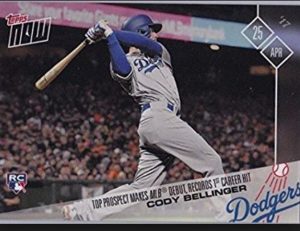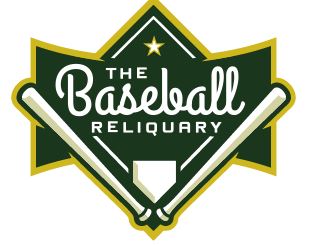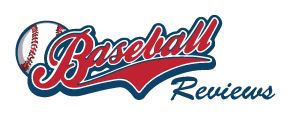Okay, what do Cody Bellinger and Eric Valent have in common? Or Dave “King Kong” Kingman and Michael “Pinky” Higgins? Or Mox McQuery and Oddibe McDowell?
 The answer: They all hit for the cycle as major league rookies. On July 15, as much was made of Cody Bellinger becoming the first Dodger rookie to hit for the cycle, I started wondering just how many of MLB’s 310 cycles were achieved by rookies. I’ve identified 25 such occurences and we’ll take a look at each of those players in this post, but first a few bits of trivia.
The answer: They all hit for the cycle as major league rookies. On July 15, as much was made of Cody Bellinger becoming the first Dodger rookie to hit for the cycle, I started wondering just how many of MLB’s 310 cycles were achieved by rookies. I’ve identified 25 such occurences and we’ll take a look at each of those players in this post, but first a few bits of trivia.
No Cliff Hanger – Getting the Cycle Out of the Way
Cliff Heathcote (Cardinals, 1918) is the youngest rookie to hit for the cycle (20 years, 171 days), but not the youngest player ever to achieve the feat. On May 16, 1929, the Giants’ Mel Ott hit for the cycle at 20 years, 75 days of age – but he was already in his fourth MLB season.
Heathcote does hold the record for record a cycle earliest in a major league career. His came in just his sixth MLB appearance – and included his first-ever MLB double, triple and home run.
A few other “stats”:
- Of the 25 rookie cycles, six (24 percent) were achieved by center fielders batting lead off;
- In five of the 25 rookie cycles, the home run was the players’ first major league round tripper.
- The Giant’s Fred Lewis completed a rookie cycle on May 13, 2007 that included his first MLB triple, first MLB home run and just his second MLB double.
- Carlos Gomez, still active, is the only player to (thus far) to achieve a second cycle after notching a rookie cycle. Gomez’ rookie cycle came in 2008, his second cycle this April.
Eight is Enough?
We’ve already seen five cycles this season: Wil Myers (April 10); Trea Turner (April 25); Carlos Gomez (April 29); Nolan Arenado (June 18); Cody Bellinger (July 15). The most cycles achieved in any one season? Eight. Those came in 1933 (Pepper Martin, Chuck Klein, Arky Vaughn, Mickey Cochrane, Pinky Higgins, Jimmie Foxx, Earl Averill, Babe Herman) and 2009 (Orlando Hudson, Ian Kinsler, Michael Cuddyer, Melky Cabrera, Troy Tulowitzki, Felix Pie, B.J. Upton).
Now here are the 25 player to hit for the cycle as rookies:
Cody Bellinger, Dodgers … July 7, 2017
The Dodgers’ 22-year-old All Star rookie was in his 72nd MLB game, playing at 1B and batting cleanup when he completed his cycle in a 7-1 LA victory over the Marlins. Bellinger went four-for-five with two runs scored and three RBI – in a game that included his 16th double, second triple and 26th home run. As I write this post, Bellinger stands at .268-26-61 on the season and his MLB career. Note: I was going to get this out a day earlier, but I took time out to attend a youth baseball game (see more on that here.)
Brandon Barnes … Astros, July 19, 2013
The 27-year-old outfielder hit for the cycle in his 119th MLB game. He went five-for-five in the game with three runs scored and two RBI, as the Astros lost to Seattle 10-7. The triple was his only three-bagger of the season. Barnes finished 2013 at .240-8-41 (11 steals) in 136 games. In five MLB seasons, he went .242-19-100.
Carlos Gomez, Twins … May 7, 2008
Twenty-two-year-old Gomez remained a rookie in 2008, despite his 127 MLB at bats in 2007. He hit for the cycle in his 86th career game. Gomez, leading off and playing CF, went four-for-six with two runs scored and three RBI in the game (he struck out in his other two at bats) – as the Twins ripped the White Sox 13-1. Gomez finished the season at .258-7-59 and remains active in MLB (as this is written, his career line is .256-128-485).
Fred Lewis, Giants … May 13, 2007
Lewis was 26-years-old and playing in just his 16th MLB game when he completed his cycle. Lewis was leading off and playing CF in the Giants’ 15-2 thrashing of the Rockies. Lewis went five-for-six in the game (two singles), with three runs scored and four RBI. The extra-base hits were the second double, first triple and first home run of his career. Lewis finished the campaign at .287-3-19 in 58 games. He played seven seasons in the majors, with a .266-27-136 line (535 games). Notably, he hit nearly as many triples (21) as home runs (27) in his career.
Luke Scott, Astros … July 28, 2006
The 28-year-old Scott (playing right field) was in his 45th MLB game when he hit for the cycle in perfect reverse order – home run in the fourth inning, triple in the fifth, double in the seventh, single in the eleventh. Scott went four-for-six in the contest, which the Astros lost to the Diamondbacks 8-7 in eleven innings. Scott scored once and drove in five. Scott had his best MLB season in 2006, going .336-10-37 in 65 games. In a nine-year MLB career, he went .258-135-436.
Eric Valent, Mets … July 29, 2004
The 27-year-old rookie had already spent part of three seasons (2001-2003) in the majors, but still qualified as a rookie (he had appeared in just 47 MLB games) when he entered the 2004 season. On July 29, Valent was playing left field and batting seventh for the Mets, who would go on to beat the Expos 10-1. Valent went four-for-four, with three runs scored and three RBI (he also drew a walk). The season was the best of Valent’s MLB career (205 games in five seasons) – and the only campaign in which he played in more than 28 MLB games. In 2004, he went .267-13-34 in 130 contests. His career line was .234-13-37.
Travis Hafner, Indians … August 14, 2003
The 26-year-old Hafner was in his 81st career MLB game (in the DH spot) when he collected his cycle. He went four-for-five that day, with three runs scored and two RBI. His Indians topped the Twins 8-3. It was his first triple of the season. He ended 2013 at .254-14-40 and hit .273-213-731 over 12 MLB seasons.
Chris Singleton, White Sox … July 6, 1999
Singleton was a 26-year-old rookie when he hit for the cycle – in his 61st MLB game. Playing center field and batting second, Singleton went five-for-six (an extra single thrown in) with three runs scored and four RBI. Chicago still lost to Kansas City 8-7. Singleton finished the season at .300-17-72 and hit .273-45-276 in six MLB campaigns. His rookie season saw Singleton achieve career highs in hits (149), doubles (31), triples (6), home runs (17), RBI (72) and batting average (.300).
Alex Ochoa … Mets, July 3, 1996
Alex Ochoa was a 24-year-old Mets’ rookie when he hit for the cycle. Ochoa started in right field and went five-for-five (the extra hit was a double) as the Mets beat the Phillies 10-6. Ochoa scored three times and collected three RBI in the game. He finished the 1996 season at .294-4-33 (in 82 games). Ochoa played in eight MLB campaigns, hitting .279-46-261.
Ray Lankford, Cardinals … September 15, 1991
Lankford, at 24-years-old, hit for the cycle in his 170th career game, as the Cardinals bested the Mets 7-2. Lankford, leading off and playing center field, went four-for-four with four runs scored and one RBI. Lankford ended 1991 at .251-9-69 – also stealing 44 bases and leading the NL in triples with 15. He had a 14-season MLB career, hitting .272-238-874 and swiping 258 bags. He twiced topped 30 home runs and exceeded 30 steals three times.
Oddibe McDowell, Rangers … July 23, 1985
The 22-year-old McDowell was in his 59th career game when he hit for the cycle – leading off and playing CF as the Ranger topped the Indians 8-4. McDowell went five-for-five that day (an extra single), scoring three times and driving in three. He finished his rookie campaign at .239-18-42 and went .262-74-266 in seven MLB campaigns.
Gary Ward, Twins, September 18, 1980
The 26-year-old Ward achieved the cycle in just his 14th career MLB game. He went four-for-five, with two runs and two RBI as the Twins lost to the Brewers 9-8. It was Ward’s second double, second triple and first home run of the season and his career. (He was leading off and playing left field.) Ward finished 1980 at .463-1-10 in 13 games and went on to a 12-season MLB career and a line of .276-130-597.
Dave Kingman, Giants … April 16, 1972
Kingman was 23-years-old and in his 43rd MLB game when he hit for the cycle – scoring three runs and driving in six as his Giants topped the Astros 10-6. The big guy was at third base for the game, in which he went four-for-five. In what would turn out to be typical Kingman fashion, he hit .225-29-83 for the year (with 140 strikeouts in 135 games). For his 16-season MLB career, Kingman hit .236-442-1,210. He also picked up two home run titles and hit a high of 48 dingers in 1979.
Vic Wertz, Tigers, September 14, 1947
Wertz hit for the cycle in his 88th career game (at age 22) – as his Tigers bested the Senators 16-6 in the first game of a doubleheader. Wertz went four-for-five, with five runs scored (he also drew a walk) and four RBI. The left fielder finished the season at .288-6-44 and enjoyed a 17-season MLB career (.277-266-1,178), hitting 20 or more home runs in six seasons and topping 100 RBI five times.
Bill Salkeld, Pirates … August 4, 1945
The 28-year-old rookie was in his 60th MLB game, starting behind the plate for the Pirates, when he completed his cycle. Salkeld went five-for-five (an extra single), scored once and drove in five. The RBI are notable, since they were the Pirates entire output in a 6-5 loss to the Cardinals. He finished the season at .311-15-52 (95 games) and played 356 games over six MLB campaigns (.273-31-132). Salkeld hit only two triples in his MLB career.
Leon Culberson, Red Sox … July 3, 1943
The 24-year-old Culberson was in just his 31st career game when he hit for the cycle – and did it in natural order with a single in the first inning, a double in the third, a triple in the sixth (the first of his career) and a home run in the eighth (of the inside-the-park variety). Culberson, playing CF and leading off, went four-for-five with three runs scored and two RBI as the Red Sox topped the Indians 12-4. Culberson hit .272-3-34 that season, and .266-14-131 over a six-season MLB career.
Bobby Rosar, Yankees, July 19, 1940
The 26-year-old was in his 72nd career game when he hit for the cycle. He went four-for-five with four runs scored and four RBI as the Yankees blasted the Indians 15-6. The New York catcher finished the season at .298-4-37 in 73 games. He had a 13-season MLB career and a stat line of .261-18-367. Despite his low batting average, Rosar – a fine defensive catcher – was a five-time All Star and still holds a share of the AL record for consecutive games in a season without an error by a catcher (117).
Moose Solters, Red Sox … August 19, 1934
A 28-year-old rookie, Solters was in his 76th career game when he hit for the cycle as the Red Sox lost to Detsroit 8-6 in the first game of a doubleheader. The Boston center fielder went four-for-five, with two runs scored and three RBI. (He went zero-for-four in Game Two.) Solters finished the season at .299-7-58 in 101 games. His line over a nine-season MLB career was .289-83-599.
Roy Carlyle, Red Sox … July 21, 1925
Carlyle was 24-years-old and in his 48th career MLB game when he hit for the cycle in the first game of a doubleheader. The Boston left fielder went four-for-five with two runs scored and four RBI as the Red Sox beat the White 6-3. Carlyle finished the season at .325-7-49 in 94 games. He played only one more MLB campaign (1926) and ended his MLB career at .312-9-76 in 174 games. It was his glove that did him in. Carlyle’s career fielding percentage was just .910. In 233 career chances in the outfield, he booted nearly one in ten (21 errors).
Pinky Higgins, Athletics … August 6, 1933
The 24-year-old third baseman was in his 115th MLB game when he achieved the rookie cycle. Higgins went four-for-five in the game, with three runs scored and five RBI as his A’s beat the Senators 12-8. Higgins finished the season at .314-13-99 (34 doubles and 12 triples). In a 14-season MLB career, Higgins hit .292-140-1,075.
Cliff Heathcote, Cardinals … June 13, 1918
The 20-year-old Cardinals’ center fielder hit for the cycle in just his sixth major league game – a feat only slightly diminished by the fact that he had nine at bats in the 19-inning, 8-8 tie with the Phillies. Heathcote went four-for-nine in the game, with two runs scored and three RBI. The extra base hits were the first double, first triple and first home run of his MLB career. Heathcote finished the season at .259-4-32 in 88 games. In a 15-season MLB career, he hit .275-42-448. Like so many of the rookies on this list, Heathcote was leading off and playing center field.
Bill Collins, Doves (Boston) … October 6, 1910
The 28-year-old rookie outfielder achieved the first natural cycle (single, double, triple and home run in that order) as the Doves (Braves) beat the Phillies 20—7. I have not tracked the specifics, but I do know it was either the 150th or 151st game of Collins’ MLB career. That season, Collins finished .241-3-40 in 151 games – and he would play only 77 more MLB games, ending at .224-3-54. But he will always be the first play to achieve a cycle in natural order.
Pre-1900 things get a bit sketchier (and records less complete), but I have identified three “rookie cyclers” from the era. Note: I made some subjective judgments (rookie eligibility was not clearly defined back then). Basically, I took into consideration what is generally considered major league experience. For example, Fred Carroll hit for the cycle on May 2, 1887 – in his first year with the Pittsburgh Alleghenys of the National League. While it was his first year with the NL version of the Alleghenys, he had spent the previous two seasons with the American Association (considered a major league) Alleghenys, which joined the National League in 1887. With that in mind, I did not include his 1887 cycle as a rookie achievement.
Bill Van Dyke, Toledo Maumees (American Association) … July 5, 1890
The 26-year-old outfielder/third baseman finished the season at .257-2-54. He went on to play one season each for the National League Saint Louis Browns (1892) and Boston Beaneaters (1893). His final major league stats – .253-2-56 in 136 games. The home run included in his cycle was his first MLB round tripper. Despite Van Dyke’s game, the Maumees lost to the Syracuse Stars 13-12.
James “Chippy” McGarr, Philadelphia Athletics (American Association) – September 23, 1886
Before joining the Athletics in 1886, McGarr had just 19 games and 70 at bats with the Union Association Chicago/Pittburgh team (also known as the Chicago Browns/Pittsburgh Stogies). That stint came in 1884, the only year of the franchise. In 1886, he joined the Athletics and put together a .266-2-31 season (71 games at shortstop). On the day the 23-year-old hit for the cycle, his Athletics topped the St. Louis Cardinals 15-6. McGarr put up ten major league seasons, with a line of .269-9-388. The home run included in his cycle was his first major league long ball.
William “Mox” McQuery, Detroit Wolverines (National League) … September 28, 1885
The 24-year-old first baseman was in his second major league season (first in the NL), but had only 132 at bats with the Union Association’s Cincinnati Outlaw Reds the previous year (so still qualified as a rookie under today’s rules). McQuery hit .273-3-30 in 70 games for Detroit in 1995 and .271-13-160 in five major league seasons (Union Association, National League, American Association). The Wolverines topped the Providence Grays 14-2 on McQuery’s big day.
All in A Days (or two days) Work
The Expos’ Tim Foli is the only player to start a cycle one day and complete it the next. On April 21, 1976, Foli collected a single, double and triple in a contest against the Cubbies that was suspended in the top of the seventh due to darkness. When play resumed the following day, Foli added an eighth-inning home run. (The Expos prevailed 12-6.)
Key sources for this post: Baseball-Reference.com; The Society for American Baseball Research (SABR); Baseball-Almanac.com; The Baseball Encyclopedia.
I tweet baseball @DavidBBRT
Follow/Like Baseball Roundtables Facebook page, here.
Member: Society for American Baseball Research (SABR); The Baseball Reliquary; The Negro Leagues Museum; Baseball Bloggers Alliance.





